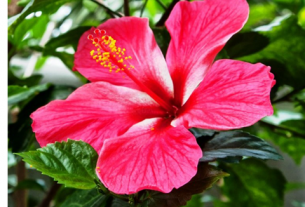By Tommy Clarkson on the Winter 2022/2023 Edition
Man does not live nor survive on meat alone! Vegetative material is a key component in our lives. Be it for food, clothing, household items or their health and healing applications, we need I’ve pulled verbatim five of these plants.
As seen through our first book series, “The Civilized Jungle,” created by Patty, Steve Jackson and me, generally, we’ve tended to focus and write about semi-tropical and tropical plants and their part in our lives. Appropriately, our next book series, “The Medicinal Jungle” with pictures of its plants will soon be introduced.
 As but the tiniest of glimpsesethnopharmeceutical plants from the alphabetical “A” section, as ensues. (Purposefully, I have selected more commonly known species and some that are also featured in our earlier series, for those seeking expanded awareness of these plants.)
As but the tiniest of glimpsesethnopharmeceutical plants from the alphabetical “A” section, as ensues. (Purposefully, I have selected more commonly known species and some that are also featured in our earlier series, for those seeking expanded awareness of these plants.)
The first of these is the African Oil Palm (Elaeis guineensis) The Civilized Jungle, Volume I. Also known as: Macaw Fat Tree. Family: Arecoideae. Origin: Angola and Gambia. Traditional, purported and contemporary uses: (Nifty Nugget of Knowledge:
The use of Palm oil goes back thousands of years, with the oldest record of its usage dating from 3,000 BC, as confirmed when archaeologists discovered vessels of it encased in a tomb in Abydos, Egypt.)
Palm oil is supposedly an anodyne, antidotal and aphrodisiac, as well as being used to fight cancer, headaches, indolent tumors and rheumatism. Additionally, a decoction of it can be taken orally to treat epilepsy.
In Guinea, its oil is applied to wounds as a vulnerary. The Bubis (a Bantu ethnic group) from the Island of Fernando Po make a poultice from this oil which they, also, apply to wounds. In Equatorial West African, some of its plant parts have long been used as a diuretic and as a laxative. In South Eastern Nigeria, it is used for treatment of various diseases and skin infections.
 Amaryllis (Amaryllis belladonna) The Civilized Jungle, Volume II. Also known as: Belladonna Lily, Jersey Lily, March Lily, Naked Lady and Amarillo. Family: Amaryllidaceae. Origin: The Western Cape region of South Africa. Traditional, purported and contemporary uses.
Amaryllis (Amaryllis belladonna) The Civilized Jungle, Volume II. Also known as: Belladonna Lily, Jersey Lily, March Lily, Naked Lady and Amarillo. Family: Amaryllidaceae. Origin: The Western Cape region of South Africa. Traditional, purported and contemporary uses.
In the Andean South America, the Mediterranean and South Africa, the Amaryllis belladonna is said to be used in the treatment of cancer. In the southern portion of the enclave within South Africa, Lesotho, various parts of it are used to treat colds, coughs, and as an external application or wash for hemorrhoids, scrofula and wounds. It is also used by the Zulu, Xhosa and Sotho people as a remedy for gynecological problems.
It would seem that, with the exception of its leaves, all parts of the Amaryllis have medicinal qualities. The bulb is purgative.
When it is crushed in water, boiled or roasted, it is used in the treatment of stomach aches. Beyond those applications, the Amaryllis has also been used in treatment of whooping cough and, lastly, the alkaloids within it have properties to fight against malaria. (Nifty Nugget of Knowledge: The genus name, Amaryllis, is derived comes from the Greek word amarysso meaning “to sparkle,” with their bulbs surviving and blooming for up to 75 years.)
 Angel’s Trumpet (Brugmansia x candida) The Civilized Jungle, Vol. III. Also known as: Angel Star, Angel’s Tears, Brazil’s White Angel Trumpet, Cornucopia, Datura, Devil’s Trumpet, Downy Thorn-apple, Hindu Datura, Hindu Thorn apple, Hoary Thorn apple, Horn of plenty, Jimson Weed, Metel, Night Bells, Purple Thorn apple, Queen of the Night, Snowy Angel’s Trumpet, Thorn Apple, Trumpet Flower and White Angel’s Trumpet. Family: Solanaceae Origin: Southeastern Brazil. Traditional, purported and contemporary uses: (Nifty Nugget of Knowledge: Angel Trumpets are closely related to potato, tomato, eggplant, petunia and tobacco.)
Angel’s Trumpet (Brugmansia x candida) The Civilized Jungle, Vol. III. Also known as: Angel Star, Angel’s Tears, Brazil’s White Angel Trumpet, Cornucopia, Datura, Devil’s Trumpet, Downy Thorn-apple, Hindu Datura, Hindu Thorn apple, Hoary Thorn apple, Horn of plenty, Jimson Weed, Metel, Night Bells, Purple Thorn apple, Queen of the Night, Snowy Angel’s Trumpet, Thorn Apple, Trumpet Flower and White Angel’s Trumpet. Family: Solanaceae Origin: Southeastern Brazil. Traditional, purported and contemporary uses: (Nifty Nugget of Knowledge: Angel Trumpets are closely related to potato, tomato, eggplant, petunia and tobacco.)
Before going much further know that, for all intents and purposes, this plant is one of a rather poisonous nature. As I read online, “At best, eating the flower will result in terrifying hallucinations, but at worst, it can leave you dead.
 In spite of that, to achieve relief from their asthma, Brazilian natives have smoked the leaves. But, if the truth be known, they realize strong narcotic effects, so is the plant really medicinal in this regard?
In spite of that, to achieve relief from their asthma, Brazilian natives have smoked the leaves. But, if the truth be known, they realize strong narcotic effects, so is the plant really medicinal in this regard?
Beyond that, deep in the jungle, it has also been used for aches, arthritis, burns, dermatitis, headaches, infections, rheumatism, skin irritation and different types of inflammations.
Of a more contemporary nature, its tropane alkaloids, such as scopolamine and atropine have actually been incorporated in minute amounts, mind you on patches for motion sickness.
Anthurium (Anthurium andreanum) The Medicinal Jungle, Vol-ume II. Also known as: Boy Flower, Flamingo Lily, Flamingo Flower, Little Boy Flower, Painted Tongue, Palette Flower, Patent Leather Flower Spathe Flower and Tail Flower. Family: Araceae Origin: Columbia and Ecuador Traditional, purported and con-temporary uses: We all have to find our own, unique [and sometimes specific] niche in the world, and such is certainly the case, ethnobotanically, for the Anthurium!
In traditional medicine while under a blanket cover by inhaling the steam from boiling Anthurium leaves, arthritis and rheumatism joint pain are said to be relieved. (Tulips, petunia and roses can make no such claim, I bet!)
Additionally, as an indoor plant it naturally and effectively removes chemicals such as ammonia and formaldehyde from the air.
Asparagus Fern (Protasparagus densiflorus) The Civilized Jungle, Volume I. Also known as: Basket Asparagus, Bushy Asparagus and Emerald Fern. Family: Asparagaceae. Origin: The South-eastern part of the Cape of Good Hope in South Africa. Tradi-tional, purported and contemporary uses: Its mashed leaves may be applied to cuts and its tubers have been given to children for stomach ache. In Mexico a decoction of the branches are used for pulmonary infections and its roots used as a diuretic.
In Tanzania, a cold infusion of leaves and stem are drunk for malaria. In Pakistan, root tubers with boiled milk and sugar are used for dysentery and diarrhea.
There are indications that it may also help with breast cancer, chronic bronchitis, diphtheria, dry throat, and tuberculosis, as well as being good for both the lungs and kidneys.
Plant questions – medicinal or otherwise? Feel free to contact me at tomolabrisa@gmail.com
—
Tommy Clarkson is a bit of a renaissance man. He’s lived and worked in locales as disparate as the 1.2 square mile island of Kwajalein to war-torn Iraq, from aboard he and Patty’s boat berthed out of Sea Bright, NJ to Thailand, Germany, Hawaii and Viet Nam; He’s taught classes and courses on creative writing and mass communications from the elementary grades to graduate level; He’s spoken to a wide array of meetings, conferences and assemblages on topics as varied as Buddhism, strategic marketing and tropical plants; In the latter category he and Patty’s recently book, “The Civilized Jungle” – written for the lay gardener – has been heralded as “the best tropical plant book in the last ten years”; And, according to Trip Advisor, their spectacular tropical creation – Ola Brisa Gardens – is the “Number One Tour destination in Manzanillo”.



